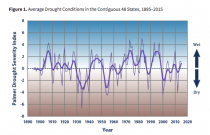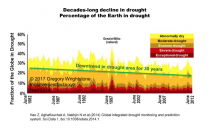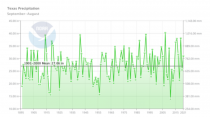By who else but Seth Borenstein AP. ---

“The American West’s megadrought deepened so much last year that it is now the driest in at least 1,200 years and is a worst-case climate change scenario playing out live, a new study finds.
A dramatic drying in 2021 - about as dry as 2002 and one of the driest years ever recorded for the region - pushed the 22-year drought past the previous record-holder for megadroughts in the late 1500s and shows no signs of easing in the near future, according to a study Monday in the journal Nature Climate Change.
The study calculated that 42% of this megadrought can be attributed to human-caused climate change.”
-------------------
As the graph below from NOAA’s NCEI for the western U.S. shows there are dry and wet years often explained by El Ninos and La Ninas, the trend is “flat” since 1895.
When droughts are severe or persist for more than a season, talk of a permanent change to a megadrought or permadrought often begin. There is no sense of history in these claims. A 2015 study (Cook etal) found that Megadroughts in the past 2000 years were worse and lasted longer than current droughts. When drought began in Texas in 2010 and worsened in 2011, alarmists claimed this event marked the start of a ‘permadrought’. Some worried that as a farming and cattle ranching region, Texas was essentially finished. Three wet years followed culminating with the major flooding from Hurricane Harvey. The Texas drought was over.
So then alarmists changed their warnings and claimed that the flooding from Harvey was the result of climate change and an era of severe flooding storms had begun. However, the record below for precipitation in Texas shows a flat trend seen with the wet and dry periods. It does show the worst drought stretch 6 years long occurred in the 1950s. But, large swings are common.
In California there were four dry to very dry years ending in 2014 and the alarmists were again proclaiming a Permadrought there. However a record wet/snowy year occurred in the west with the heaviest snows in the Northern Sierra Nevada Mountains in 2016/17. It resulted in an accumulation of over 750 inches (63 feet) of snow at one location. Within months the California drought ended. Drought returned the following year followed by another wet year before the wet 2019/20. Then the 2020/21 water year western drought followed. It ranked with 1923/24 and 1976/77 as the driest in the Sierras. Despite these ups and downs, the long-term trend is flat.
See the monthly precipitation this season in the Sierra - a wet October and December and dry between. See the driest and wettest years. 1923/24 an 1976/77 were the driest with 2020/21 just behind.
The EPA shows declining drought in the U.S.

Enlarged
Hao etal (2014) showed global drought has declined. Note drought and flood locations relate to the ocean cycles like El Nino or La Nina. Note the Sahara desert has shrunk 8% since the 1970s.

Enlarged
And again droughts in California are not new. The drought of 1862-1863 ended the cattle industry in Southern California here.









